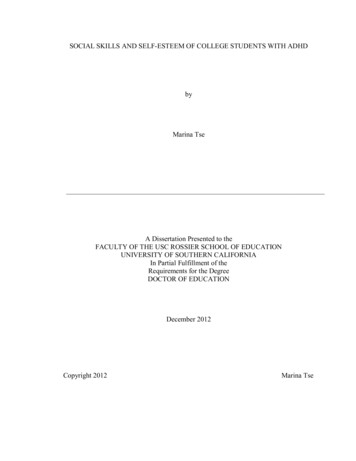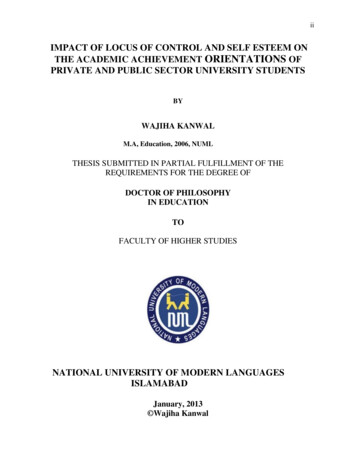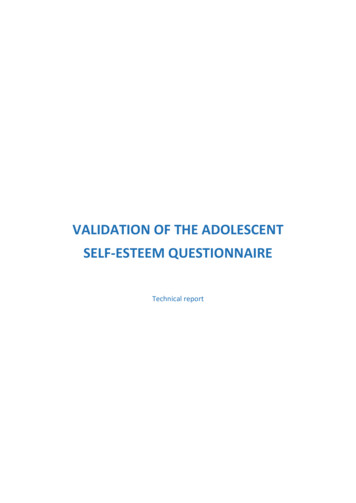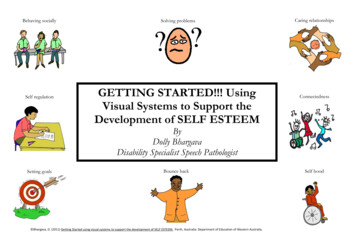
Transcription
SOCIAL SKILLS AND SELF-ESTEEM OF COLLEGE STUDENTS WITH ADHDbyMarina TseA Dissertation Presented to theFACULTY OF THE USC ROSSIER SCHOOL OF EDUCATIONUNIVERSITY OF SOUTHERN CALIFORNIAIn Partial Fulfillment of theRequirements for the DegreeDOCTOR OF EDUCATIONDecember 2012Copyright 2012Marina Tse
UMI Number: 3551788All rights reservedINFORMATION TO ALL USERSThe quality of this reproduction is dependent upon the quality of the copy submitted.In the unlikely event that the author did not send a complete manuscriptand there are missing pages, these will be noted. Also, if material had to be removed,a note will indicate the deletion.UMI 3551788Published by ProQuest LLC (2013). Copyright in the Dissertation held by the Author.Microform Edition ProQuest LLC.All rights reserved. This work is protected againstunauthorized copying under Title 17, United States CodeProQuest LLC.789 East Eisenhower ParkwayP.O. Box 1346Ann Arbor, MI 48106 - 1346
iiTable of ContentsList of TablesviAbstractviiChapter 1: The ProblemBackground of the ProblemStatement of the ProblemPurpose of the StudyHypothesesResearch QuestionsIntroduction of TheoriesImportance of this StudyLimitations and DelimitationsDefinition of TermsChapter 2: Literature ReviewIntroductionSynthesis of the LiteratureThe Challenges Facing College Students with ADHDCollege Students with ADHD and their Social SkillsCollege Students with ADHD and their Self-EsteemPresentation of TheoriesSummary11233336881010111118232629
iiiChapter 3: MethodologyIntroductionResearch MethodologyHypotheses and Research QuestionsHypothesesResearch QuestionsSample and PopulationData Collection and ProceduresQuantitative MethodologyInstrumentationReliability and Validity of the instrumentsThe Description of the SampleQuantitative Analytical ProcedureQualitative Research MethodologyGuiding Questions for InterviewsDescription of the SampleData CollectionData Analysis ProcessDescription of the Tool: Atlas.tiAnalysisRole of the ResearcherFact Sheet about this Study32323233333333333435353636373839394141414243
ivChapter 4: FindingsIntroductionHypotheses and Research QuestionsHypothesesResearch QuestionsQuantitative ResearchSample of StudyInstrumentationReliability and Validity of the InstrumentsResults of the Quantitative ResearchManova FindingsHypothesis OneHypothesis TwoT Test ResultsQualitative ResearchData CollectionRole of the ResearcherData Processes and ProceduresProfile of Each of the Eight IndividualsData AnalysisResults of the Qualitative ResearchContent Areas and ThemesDiagnosed as ChildrenADHD SymptomsFamily SupportAccommodations at the DSC (Disability Service Center)Self-EsteemSocial Skills and Life ImpactsMedicationGoals and ProfessionsSummary of FindingsResearch Question OneResearch Question TwoAdditional FindingsResearch 667687375768082838686878788
vChapter 5: DiscussionIntroductionQuantitative StudyQualitative StudyResults of the Quantitative Study and the Qualitative StudyImplications for PractitionersAdditional FindingsRecommendations for Future ResearchLimitations of this StudyDelimitations of this s108AppendicesAppendix A:Appendix B:Appendix C:Appendix D:Appendix E:Appendix F:Social Interaction Anxiety ScaleRosenberg Self Esteem ScaleProfile Information FormGuiding Questions for InterviewsIRBGeneral Recruitment Letter117117118119121122123
viList of TablesTable 1: Study Sample of Participants39Table 2: Multivariate Tests47Table 3: Frequency Counts for Selected Variables (N 88)48Table 4: Psychometric Characteristics for the Primary Scale Scores (N 88)50Table 5: T Test Comparisons for Social Anxiety and Self-Esteem Scale ScoresBased on Group (N 88)51Table 6: Alphabetical List of Initial Data Codes (from Atlas Ti)65Table 7: Themes of this Study66Table 8: ADHD Symptoms Experienced by Study Participants (8)68Table 9: Professional Study Areas of Participants and Reasons for theSelection85
viiAbstractResearch indicates that up to 65% of children diagnosed with ADHD maycontinue to display general behavior problems, as well as specific symptoms of ADHD,later in life. In most of the studies, ADHD college students’ self-esteem is stronglyaligned with their social skills. The purpose of this study was to find directions that willassist ADHD students to succeed at college by identifying which factors affect theirsocial skills and self-esteem, and, consequently, affect their academic achievement, theirlives, and their careers.This study used a mixed method approach in which qualitative and quantitativeresearch were combined. There were 88 participants, 44 ADHD students and 44 nonADHD students from two two-year community colleges and a four-year privateuniversity. For quantitative research, the 44 ADHD students and the 44 non ADHDstudents, from these three institutions, completed three surveys; the Profile InformationForm, the Social Interaction Anxiety Scale Survey Schedule and the Rosenberg SelfEsteem Scale questionnaires. The T-Test and MANOVA were utilized to measure thesignificance of the ADHD students’ social skills and self-esteem compared to nonADHD students. In qualitative study, eight themes to emerge from the interview data areas follows: 1) Diagnosis/Childhood Experiences, 2) ADHD Symptoms, 3) Self Esteem,4) Family Support, 5) College accommodations, 6) Social Skills, 7) Medication, and 8)Goals and Professions.The result of the T-Test and the MANOVA test also illustrate that collegestudents with ADHD have a lower level of self-esteem and poorer social skills whencompared to the group of students without ADHD. These eight themes illustrate that
viiiADHD symptoms affect participants’ self-esteem and social skills and that between theirsocial skills and self-esteem affect their social interactions and their academicachievement in college.
1Chapter 1: The ProblemBackground of the ProblemAlthough Attention Deficit Hyperactivity Disorder (ADHD) was once believed toaffect only children, recent research indicates that the symptoms of ADHD persist pastchildhood and adolescence, well into college age and beyond (Weiss & Hechtman,1993). According to some studies, this can cause a variety of problems in numerousdomains, including school, work, and home. Those with ADHD who attend college mayhave a more difficult time dealing with academic, social, and career-planning demands(Norwak, Norvilitis and MacLean, 2009).The National Resource Center on ADHD has also characterized many individualswith ADHD as having difficulty with “executive functioning.” This term refers to thefunctions within the brain that “activate, organize, integrate, and manage otherfunctions.” In other words, executive functioning allows individuals to think about goalsand the results of actions, plan consequently, evaluate progress, and shift plans as a result(Barkeley, 2009). In colleges, parents and professors expect a student to start doing thesethings more independently, and, sometimes. that transition can be difficult for studentswith ADHD. Norwalk, Norvilitis, and MacLean (2009) found that college students withADHD may have more difficulty than non-ADHD students in dealing with demandsrelated to such areas as academics, their social lives, and their ability to plan for acareer. In turn, these frustrations have led to lower college success rates and higher dropout rates.
2Statement of the ProblemAs Weiss and Hechtman (1993) stated, ADHD is increasingly being recognizedas a disorder whose symptoms persist into adulthood. Researchers estimate that 50% to65% of children diagnosed with ADHD may continue to display general behaviorproblems as well as specific symptoms of ADHD later in life. These individuals mayexhibit delinquent and antisocial behaviors during adolescence (Merrell & Tymms, 2001;Barkley, 2006) and often experience difficulties in educational performance,occupational functioning, interpersonal relationships, and self-esteem in adulthood(Barkley, Murphy, & Kwasnik, 1996; Murphy & Barkley, 1996; Barkley, 2006).One subpopulation of adults with ADHD that has been the focus of recentresearch, is the college student population. Estimates of the prevalence of ADHD incollege students vary, ranging from 2% to 8%, depending on the criteria used to assesssymptoms (DuPaul, Weyandt, O’Dells and Varejao 2008). It has been suggested that thesymptom profiles of college students with ADHD may differ from that of the typicaladult with this disorder.The ability to successfully interact with others is considered one of the mostimportant aspects of social development for all ages. Some researchers show thatinadequate social skills used to interact with peers can affect an ADHD individuals’progress in many areas and are critical to interpersonal success (Elliot & Gresham, 1987).In addition to the challenges discussed in different studies for college studentswith ADHD, the majority of studies also report consistent deficits in social skills. Asnoted in the studies of overall outcome, these deficits in social skills appear to continueinto adulthood.
3In discussions of ADHD students’ increasing functioning and educationalattainment, the majority of studies also reported consistent deficits in self-esteem.College students with a history of ADHD in childhood were found to have significantlylower self-esteem in comparison to a control group not acknowledged to have ADHDsymptoms (Dooling-Litfin & Rosén, 1997).Purpose of the StudyThis study explored how ADHD symptoms are related to college ADHDstudents’ adjustment, especially in the areas of social skills and self-esteem. The finalgoal of this study was to investigate whether the social skills and self-esteem of collegestudents with ADHD affect their college interaction and academic achievement.Hypotheses1. College students who meet the criteria for ADHD will report a lower level ofsocial skills, compared to a group of college students with no history of ADHD.2.College students with ADHD will have a lower level of self-esteem compared toa group of students without ADHD.Research Questions1. What role do ADHD symptoms play in social skills and self-esteem of the ADHDcollege students?2. What role do social skills and self-esteem of college students with ADHD play intheir social interaction and academic achievement?Introduction of TheoriesShaw-Zirt, Popali-Lehane, Chaplin, and Bergman (2005) found that collegestudents with ADHD exhibited lower levels of adjustment, social skills, and self-esteem
4as compared to a matched control group. According to Landgraf (2007), increasingevidence suggests that ADHD, a neurobehavioral disorder, persists across the life cycleand is associated with a wide range of adverse psychiatric outcomes: substance use,misuse; persistent life impairments because of low self-esteem; marital discord; poorcommunication and parenting skills; and academic and employment underachievement.Kalbag and Levin (2005) suggest that the prevalence of ADHD in the general adultpopulation ranges from 1% to 5%, but it is estimated to be much higher (11% to 35%) insubstance-abusing adults.Children with ADHD are more likely to encounter rejection from their peers andthrough negative interactions at home as well. In fact, recent work has linked childhoodADHD (Clarke, Ungerer, Chahoud, Johnson, & Stiefel, 2002) and its often co-morbidoppositional behavior (Gomez & Gomez, 2002) to negative attachment, implying thateven rejection by parents, in many instances, is persistent. Downey and colleagues(1998, 2000) proposed that precisely this kind of early rejection can lead to elevatedrejection sensitivity, which, in turn, can influence relational adjustment throughadulthood. Negative outcomes seen in children and adolescents with high rejectionsensitivity resulted in increased conflict with schoolmates, staff, and early datingpartners, as well as lower social competence as reported by the children’s teachers(Downey, Freitas, Michaelis, & Khouri, 1998; Purdie & Downey, 2000). Adults withgreater rejection sensitivity also showed jealousy and aggression towards their romanticpartners, contributing to elevated unhappiness by their partners and leading totermination of relationships over a one year period (Downey & Feldman, 1996; Downeyet al., 1998). Given that chronic rejection in childhood often co-occurs with ADHD, it
5seems possible that rejection sensitivity contributes to enduring lack of social skills andself-esteem.Additionally, longitudinal studies of children with ADHD have shown poorersocial skills during adulthood when compared to non-ADHD peers (Weiss & Hechtman,1993). Wolf (2001) argued that peer relations and social skill deficits are significantcontributing factors to the poor academic performance and high attrition rates of collegestudents with hidden disabilities such as ADHD.Prior research shows that rejection of children with ADHD occurs in peer groupsand among family members. Also, young adults with ADHD report significantly moredifficulty in interpersonal relationships than do persons without ADHD, and studies ofchildren with ADHD reveal poorer social skills during adulthood when compared to theirnon-ADHD peers.In terms of college adjustment, Shaw-Zirt’s study (2005) of ADHD studentsfound significantly lower scores on SACQ (The Student Adaptation to CollegeQuestionnaire, Vaker & Siryk, 1989) than non-ADHD students.The tendency is “to anxiously overreact to rejection,” which can lead to elevatedrejection sensitivity, and, in turn, can influence relational adjustment through adulthood.Given that chronic rejection in childhood often co-occurs with ADHD, it seems possiblethat rejection sensitivity contributes to enduring poor social skills and self-esteem.Healy (2000) recently found that college students with ADHD rated themselvesas having more difficulty paying attention during lectures than college students withoutADHD and many reported having distracting thoughts during lectures and while working
6with peers. As Burscack (1989) stated, problems with impulsivity, sleeping, and anxietydisorder have strongly affect academic achievement.Heiligenstein, Guenther, Levy, Savino, and Fulwiler’s study (1999) assessedacademic measures in college students with ADHD and compared the results to a nonADHD control group. They found that the students with ADHD achieved lower GPAs,self-reported more academic problems than the control group, and were more likely thantheir peers to be on academic probation.Fewer students with ADHD attend postsecondary institutions, and, of those whodo, fewer complete degree programs relative to non-ADHD peers (Barkley et al., 2008).College students with ADHD may have more difficulty than non-ADHD students indealing with the demands related to areas such as academics, social and daily lives, andthe ability to plan for a career. In turn, these frustrations have led to lower collegesuccess rates and higher drop-out rates.Importance of this StudyIn this study, data analysis (surveys and interviews) sought to reveal whethercollege students with an ADHD diagnosis have poor social skills as compared to nonADHD students and whether college students with an ADHD diagnosis have lower selfesteem than non-ADHD students. Furthermore, the data were analyzed as to how theseADHD symptoms play a role in social skills and self-esteem and whether low socialskills and self-esteem of college students with ADHD affect their college adjustment andacademic achievement.In a society which judges a person’s worth as a human being according to his/herachievements, ADHD individuals may be considered to be a burden to society because
7they are not motivated to achieve. They are often marginalized and rejected, regardlessof the fact that they have the potential to become productive, self-actualizing members ofsociety if given the opportunity to overcome their handicaps. Feelingsof rejection from peers and low achievement have great impact on the self-esteem ofthese ADHD college students.College students with ADHD appear greatly at risk for difficulties with socialrelationships and adjustment to college life. These difficulties are associated with selfesteem and family climate factors. Further, there may be important differences in socialfunctioning, particularly with respect to interactions with the opposite sex. Findings needto be replicated with larger, more representative samples and extended to identifycollege students with ADHD who seem to find adjustment to college life difficult,especially when it comes to establishing social relationships and self-esteem(Weyandt and DuPaul, 2008).Most studies find ADHD college students’ self-esteem is strongly aligned withtheir social skills. In turn, these frustrations have led to lower college success rates andhigher drop-out rates. Fewer students with ADHD attend postsecondary institutions, and,of those who do, fewer complete degree programs relative to non-ADHD peers (Barkleyet al. 2008). The purpose of this study was to find directions toward which ADHDstudents can turn to succeed at college by identifying their social problems and their lowself-esteem caused by their symptoms.Surveys and student interviews were conducted with volunteers fromundergraduate college students from one private four-year university and one public fouryear university. Each university selected 44 non-ADHD students and 44 students with
8ADHD who receive accommodations for having ADHD symptoms. All 88 were asked tofill out the Social Interaction Anxiety Scale Survey Schedule and the Rosenberg SelfEsteem Scale questionnaires. Interviews were conducted with 8 college students withADHD, who came from the above group of 44 students with ADHD who receiveaccommodation for having ADHD symptoms.Postsecondary institutions can use information obtained through this study todesign accommodations that assist students with ADHD to be successful in college.Limitations and DelimitationsLimitations: The sample size is relatively small, which may lead to decreasedpower in some of the analyses conducted.Delimitations: The diagnosis is based on both self-reported surveys andinterviews with students on school campuses. This allows for a more comprehensiveevaluation of symptom history. This study includes a non-referred, community sample ofcollege students from a variety of ethnic backgrounds. Thus, the present sample is morerepresentative of the general young adult population than the sample of clinic-referredstudents or of individuals diagnosed when younger and followed through adolescence.Definition of TermsADHD: Attention Deficit Hyperactivity Disorder, a neurobehavioral disorderwhich causes difficulties with sustained focus and concentration. The main symptomsrequired for a diagnosis of adults with ADHD—inattention, hyperactivity and impulsivity(NRC, 2008).Self-Esteem: According to Carl Rogers (1951), self-esteem is described to be
9essential elements in the development of a healthy psychological self when handlingeach individual well- being function. It is used to describe the way one views his/herself.Social Skill: The personal skills needed for successful social communication andinteraction.
10Chapter 2: Literature ReviewIntroductionAccording to DuPaul (2009), approximately 2% to 8% of the nation’s collegestudent population suffers with symptoms of Attention Deficit Hyperactivity Disorder, orADHD. Attention Deficit Disorder, with or without hyperactivity, is a neurologicaldisorder which causes difficulties with sustained focus and concentration. Research hasshown that this brain-based disorder runs in families and is highly genetic (Barkley,2006).The National Research Center’s report in 2006 found that the main symptomsrequired for a diagnosis of adults with ADHD, i.e. inattention, hyperactivity andimpulsivity, apply to both adults and children (NRC, 2008). However, there aredifferences. Although teens and young adults may struggle less with fewer symptoms ofhyperactivity than when they were younger, they may encompass greater challenges.They face increasing demands of schoolwork and other duties as they age, along withmore requests of their time, greater responsibilities and the demand of independentthought and study while attending college. This can feel overwhelming. Again, theNational Research Center’s report on ADHD (2008) found that other conditionscommonly experienced by college students with ADHD such as psychosocial, andneuropsychological functioning may affect how these students behave.This study assesses several aspects of the social skills and self-esteem of studentswith symptoms of ADHD in adjusting to college life and whether these students havelower interaction abilities including communication with others and confidence in their
11own abilities. The study examines in detail the symptoms that these ADHD collegestudents exhibit which affect their social skills and self-esteem.This chapter reviews some of the theories developed, symptoms identified andtreatments prescribed for ADHD college students, and whether the many studiesperformed on this disorder have been used to effectively increase the social function andself-esteem of college students with ADHD.Synthesis of the LiteratureThe Challenges Facing College Students with ADHDIn a society that judges a person’s worth as a human being according to his or herachievements, ADHD individuals may be considered a burden to society because theyare not motivated to achieve. Therefore, they are often marginalized and rejected,regardless of the fact that they have the potential to become productive, self-actualizingmembers of society if given the opportunity to overcome their handicaps.According to the American Psychiatric Association (2000), 3% to 7% of childrenattending school have ADHD, and, if left untreated, many children continue to showmeaningful symptoms throughout their lives. However, given the more extensiveamount written on childhood ADHD, less research has been conducted concerningADHD in adults, especially college students.Although teens and young adults may struggle less with fewer symptoms ofhyperactivity than when they were younger, they encounter more issues that require extraskills, energy and determination to finish assignments when they get older (NationalResearch Center, 2006). As DuPaul (2009) indicated, approximately 2% to 8% of the
12nation’s college student population suffers with symptoms of Attention DeficitHyperactivity Disorder.Weyandt et al. (1995) reported that 4-7% of college students seeking services atuniversity clinics had difficulties with attention, hyperactivity and impulsivity. Theincrease in the number of students with ADHD attending college or professional schoolsmakes it more imperative for different studies to gain further understanding into thespecific challenges that students with ADHD will face during college . Furthermore, itneeds to be understood how these challenges affect college years’ success (Weyandt,Linteman, and Rice, 1995).Also, according to the National Research Center on ADHD (2008), otherconditions commonly experienced by college students with ADHD — social,psychological, psychosocial, and neuropsychological functioning — may affect howthese students behave. Fewer adolescents with ADHD go to postsecondary education,and, of those who do, even fewer complete degree programs in relation to their nonADHD peers (Barkley et al. 2008).As previously stated (Barkley, 2006), Attention Deficit Disorder withhyperactivity is a neurological disorder characterized by inability to sustain focus andconcentration. For some college students with ADHD, chronic frustration,discouragement, and academic underachievement are the consequences of failure toacquire proper treatment and intervention aimed at helping people with ADHDto manage this disorder.Research indicates ADHD symptoms persist well past adolescence, negativelyaffecting college-age young adults, according to Norwalk, Norvilitis and MacLean
13(2009), and causing problems at school, work and home. Although it was once believedthat ADHD affected only children, Norwalk, Norvilitis and MacLean found that peoplewith ADHD attending college may have more difficulty than non-ADHD students indealing with demands related to such areas as academics, their social lives, and theirability to plan for a career. In turn, these frustrations have led to lower college successrates and higher drop-out rates.According to Landgraf (2007), increasing evidence suggests that ADHD persistsacross the life cycle and is associated with a wide range of adverse psychiatric outcomes;substance use, misuse, diversion, as well as persistent life impairments because of lowself-esteem, marital discord, poor communication and parenting skills, and academic andemployment underachievement.Heading towards adulthood with ADHD presents some unique challenges andobstacles. Once seen as a childhood illness, ADHD was considered to be something onegrew out of as maturity set in, but now we know that is not the case. According to areport from the National Resource Center, ADHD can affect social functioning andpsychological functions. A study by Weyandt and DuPaul (2006) suggest that collegestudents with ADHD in college students are at increased risk for social, psychological,psychosocial, and neurological functioning problems. The following are areas in whichstudies have shown that ADHD students differ from non-ADHD college students andprovide evidence for having difficulties in academic success.Schwanz (2007), using a sample of 68 students who self-reported an ADHDdiagnosis, carried out a systematic study of medicating ADHD symptoms and psychiatricsymptoms on the adjustment to college life. This study reported that the 68 students had
14more academic difficulties and symptoms of depression in comparison to the controlstudents. Within the ADHD students, problems with their depression and academicstudies were the result of signs of inattention, and not of overactive/impulsive behaviorsIn adults with ADHD, the Malloy-Dinz (2008) study supports the idea thatdeficits exist related to the three components of impulsive behavior: motor, cognitive,and attention. These findings are in agreement with Barkley’s supposition of inhibitorydeficit in adults with ADHD (Barkley, 1997). Malloy-Dinz also showed that the ADHDgroup had poorer accomplishment of a given task on the IGT (Iowa Gambling Task) thannon-symptomatic volunteers.A few studies have shown findings of motor impulsivity in people with ADHD(Hervey et al., 2004). Hervey (1986) found that both sets of parameters measured lowerin the ADHD group, relative to the control group. This puts forward for considerationthe notion that adults with ADHD show diminishment in a specific neural mechanism ofimpulse control, such as that detected by the CPT-II (Continuous PerformanceTask). The results reflect Barkley’s theory (1997), which suggests that ADHD subjectsshow behavioral impairments when they need to stop a pre-potent motor response.Conversely, cognitive impulsivity has tended to be connected to the orbit frontal ventromedial areas of the prefrontal cortex, with special emphasis on the more anterior sector ofthis region, the frontal pole (Bechara, et al. 2000). This particular operation may also bemore sensitive to the modulation of the serotonergic system (Rogers, et al. 2003). Someevidence suggests that this prefrontal region may be connected to the manner of thedevelopment of the disorder. Malloy-Dinz’s study (2007) showed that the ADHD group
15had poorer accomplishment of a given task on the IGT (Iowa Gambling Task) than nonsymptomatic volunteers.Garon et al. (2006) and Toplak, et al. (2005) found that the ADHD group madesignificantly more disadvantageous choices than the control group, which is consistentwith Malloy-Dinz’s findings that show people with ADHD make more unfavorabledecisions on work to be done. These studies implicate that impulsive behavior hasheavily affected the social abilities of some students with ADHD to work with othercollege students and achieve high academic levels.In some studies, anxiety disorders were found in as many as 10% to 40% of collegestudents with ADHD. The distinctive nature of anxiety disorders are shown by severaldifferent forms of abnormal and pathological fear reflected in worrying too much,difficulty controlling worries, and the resultant physical symptoms thatinclude headaches and nausea (Mc Learn & Woody, 2001).Some researchers believe that inattention and impulsivity can cause driving problemsamong the ADHD population. According to Barkley & Cox (2007), drivers with ADHDhave slower and more variable reaction times resulting in traffic violations’ moreaccidents and they make more impulsive mistakes. The study by Barkley and Coxfurther found that the use of stimulant medications by ADHD sufferers has been found tohave positive effects on driving abilities.Sleeping disorders are common in teens with ADHD. According to the NationalResearch Center (2008), a college student with ADHD may have problems getting a fulland complete sleep and may not necessarily be a side effect of medication use.
16A few studies have attempted to examine college students with ADHD and theiruse of alcohol and forbidden substances. Upadhyaya et al. (2005) found that collegestudents with ADHD who actively display symptoms were more likely to engage inoverindulgence in or dependence on an addictive substance than ADHD students whowere without current active symptoms. Kalbag and Levin (2005) suggest that theprevalence of ADHD in the general adult population ranges from 1% to 5% but isestimated to be much higher (11% to 35%) in substance-abusing adults.Tobacco use, marijuana, and drugs other than alcohol were found to be moreprevalent in students who showed a lack of symptom control. The risk of substance useamong children wit
goal of this study was to investigate whether the social skills and self-esteem of college students with ADHD affect their college interaction and academic achievement. Hypotheses 1. College students who meet the criteria for ADHD will report a lower level of social skills, compared to a group of college students with no history of ADHD. 2.











